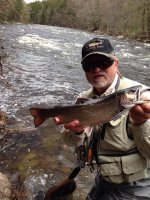wbranch
Well-known member
Many years ago I read Marinaro's "A Modern Dry Fly Code" and in it he makes reference to the outstanding wild brook trout fishing in Big Spring and how anglers came from near and far to sample the amazing fishery.
Does anyone on the Forum have any historical data talking about the brook trout in Big Spring? Was it always an outstanding brook trout fishery? Was it good all through the early 20th century? When did it start to decline and when did it basically end? Thanks to anyone who may be able to shed some light on these questions.
Does anyone on the Forum have any historical data talking about the brook trout in Big Spring? Was it always an outstanding brook trout fishery? Was it good all through the early 20th century? When did it start to decline and when did it basically end? Thanks to anyone who may be able to shed some light on these questions.




